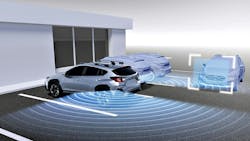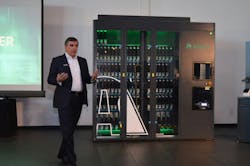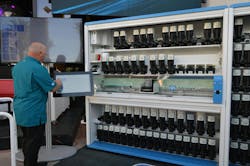Like all aspects of modern collision repair, refinishing has become more demanding. Lately, refinish manufacturers have been on a roll releasing new products for today’s vehicles to increase efficiency and shop throughput. Here’s a look at the latest in refinishing.
AkzoNobel introduces radar-transparent color formulas
As part of rear cross-traffic alert or blind spot monitoring features of an advanced driver assistance system (ADAS), radar sensors found behind bumper covers can help keep drivers avoid certain collisions. But that placement means at minimum, they’re sensitive to the proximity of repairs to the sensor. Some makes and models can be refinished only once. And some (typically high-metallic) colors may be allowed only one finish, which means a new bumper cover. (Check the OEM repair procedures to be sure!)
In late November, AkzoNobel introduced more than 200 OEM-approved radar-transparent color formulas for Lesonal and Sikkens color finishes through its cloud-based Mixit color retrieval application. The company has developed and tested the formulas to meet the strict specifications and application requirements of each manufacturer.According to a company news release, “more than 60% of color formulations for the automotive industry now contain metallic toners, which can potentially attenuate the radar signal. Solid colors, mica and metallic paints all impact the signal transmission in different ways, as does the thickness of the coating and the number of layers applied; weaker radar signals can make the car vulnerable and fail to detect potential danger within its environment.” In the release, George Sneddon, AkzoNobel OEM Technical Program Manager, says in the worst case, the signals can be totally reflected by a metal layer.
“That’s why we’re working hand-in-hand with the OEMs to support bodyshops with our knowledge, expertise, and product range to meet their immediate needs, and equip them to meet the demands of future vehicles.”
AkzoNobel has also launched a comprehensive online training package comprising e-learning modules in multiple languages to cover general information on radar and sensor technology and to guide body shops through the future repair process.
Axalta’s Irus fully automates mixing
As we first told you from the SEMA Show at the time of its introduction to media representatives, Axalta Coating Systems’ fully automated Irus Mix is rolling out to North American shops midyear this year after being introduced in the Netherlands in May 2023.
At an average of five mixes per day and an average 10 minutes of labor required for each conventional, manual mix, the time saved by a painter who can be painting instead of mixing really adds up, said James Muse, vice president of global sales for Axalta Refinish.
"That's 208 hours a year, or three-plus weeks of time you're not paid for," he said at the time of the demo, which took less than five minutes to mix Lunar Rock, the color of the 2021 Toyota Tacoma used for the scanning, matching, and mixing demonstration. "Time is money; your painter should be painting, not mixing. "The new fully automated Irus Mix system embodies "innovation with purpose," he said. With fully automated mixing, there are no overpours or other mistakes made by manual mixing, so the system eliminates waste. The easy-to-use system is also one way to address the technician shortage, he noted.
Toners are packaged in plastic bottles, sized by their usage (low-use specialty toners are only 100 ml, as an example.) Once the color is scanned and input into the computer, the mixing machine's carriage retrieves each toner from the cabinet, gives it a gentle shake to agitate it, and pours it into the cup placed on the scale at the lower right of the machine.
Axalta partnered with Santint, a global equipment manufacturer, for the concept, development, design, and construction of Axalta Irus Mix.
See the Irus Mix in action here.
All of Axalta's premium basecoat systems: Spies Hecker Permahyd Hi-TEC, Cromax Pro, and Standox Standoblue, are available in the new bottling system used with Irus Mix.
"At Axalta, innovation is central to our business," said Troy Weaver, senior vice president, Global Refinish. "We constantly look for ways to help our customers to do business better, enabling them to work as efficiently as possible and to maximize their profitability."
BASF’s R-M brand introduces first one-coat clear, RMC1000
BASF representatives say the R-M brand’s RMC1000, the refinish industry’s first one-coat clear, meets the market’s demand for increased productivity.
With the ability to apply one wet coat and a 30-minute force-cure at 140F, customers can save at least 10 minutes by eliminating the second coat and the flash-time that would otherwise be required between coats. according to a company news release. That allows an extra .6 booth cycles per day compared to a competitive 1.5-coat clear. At an average R.O. of $3,750, that adds up to $564,000 per year in additional revenue.
For additional perspective on how it fits in the product lineup and what application adjustments may be needed in the booth, we followed up with BASF representatives.
Cinthia Gutierrez Oliveros, premium segment manager, Americas, said using this product can save customers $2,000 in energy savings because of less booth run time, and 7,000 pounds of CO2, the equivalent of driving a car more than 6,000 miles.
“That's something we are aiming for with our premium brands to bring value, such as through efficiencies in speed and consumption,” she says.
The product is priced for the mass market, says Holli Schwartz, product manager for clears and undercoats.
“When we look at applications versus some of the other one-and-a-half to two-coat clears on the market, RMC1000 provides material consumption savings, and we're looking at a reasonable market price for the value it provides."
Bill Bierie, BASF head of applications for North America, says the new clear is not a specialty product but has instead been designed to take the place of a core production clear.
The product is designed with sag resistance and to have the same film build as conventional clears to deliver equivalent UV protection. Bierie notes having sufficient film build is also necessary to be able to correct defects such as dirt nibs.
“And it helps provide that nice flow-out and exceptional appearance.”
Painters shooting the new RMC1000 need to adjust their technique slightly, but they quickly adapt.
“With most clear coats with a two-coat application or even a coat and a half application, you're really at that 50, maybe 60% overlap," he says. "And that's primarily because that clear coat needs time to settle and create a film and not sag and run as you're applying it. Because of the special technology that RMC 1000 has, we're able to have all that sag resistance right away and not have running or any kind of issues like that. And so to take advantage of that property, the painter does need to adjust and slow their application down to more of like an 80% overlap in that one coat."
Bierie says some painters who are used to using a 1.2 fluid nozzle for clear coat should upsize to at least a 1.3 nozzle to ensure they get the correct film build for durability.
“Also related to application: painters often use that second coat of clear to help fix a dry spot here and there or something like that. You can do the same thing with RMC 1000. It's got a great melt-in window of about 15 minutes or so after that first coat's applied.”
The company’s trials in shops in shops won over the painters, Schwartz says. “What we're hearing them say is that this is a game-changer and this is truly a fantastic product. They might have come in with a little bit of excitement, maybe a little hesitation and even disbelief: 'Is this really achievable?' But they try it once and then they can just run with it.”
PPG enhances technology in the body shop
PPG recently introduced a number of technology-enabled enhancements for productivity, including its automated MoonWalk mixing system. MagicBox is a compact device used with PPG’s LINQ Color software to complete the mix by using a smartphone. It's also equipped with sensors to automatically detect humidity and temperature, which allows it to recommend the correct primers and clearcoats to use for those conditions, along with the correct ratio and combination.
Its latest technology is the AdjustRite commercial estimating system, a mobile-friendly platform for enhanced productivity for commercial vehicle repairs It provides technicians a time clock system and automated tracking of their work hours per repair orders. According to a news release,. "shop managers and estimators benefit from a centralized approach to delegate tasks, gain insights from productivity metrics and efficiency data, and utilize dynamic charts for a thorough overview of repair orders and technician activities.”
“Given current industry challenges such as labor shortages and time management, the PPG AdjustRite Repair Management tool emerges as a critical solution for repairs to commercial vehicles including heavy and medium trucks, trailers, buses, motor coaches, recreational vehicles and box trucks,” said Douglas Orr, PPG AdjustRite platform manager, Automotive Refinish, in the release. “Users can track technician time and efficiently delegate tasks while gaining an overall view of shop activities through a detailed dashboard and visual charts to maximize productivity.”
PPG says the platform is intended for commercial truck dealers, independent collision repair centers, fleet repair units, independent adjusters and insurance firms. It includes a comprehensive database of truck parts and repair data that allows shops to generate accurate estimates using truck model specific-data The includes overhaul, overlap, included operations, additional operations, and additional parts or materials associated with the repair.
The automated MoonWalk system minimizes material consumption, and as a self-contained system, it provides a clean, splash-free workspace. It's sized to fit all mixing rooms and features 80 storage spaces for toners and 13 positions in the dispensing rack. The user loads the required toner, additive and thinner bottles into the rack, and the system checks each bottle’s barcode, automatically dispensing the correct amount of product and printing a label. Once the mix ingredients are loaded into the system, the painter can walk away and spray adhesion promoter, sealer, or another labor process while the system starts mixing (done in few minutes.) With a conventional mixing machine, the average painter takes from 10 to 12 minutes to mix a formula, and rushing the process often introduces errors. So, the MoonWalk's selling points are its greater productivity and efficiency while also limiting the potential for human error.
About the Author
Jay Sicht
Editor-in-Chief, FenderBender and ABRN
Jay Sicht is editor-in-chief of FenderBender and ABRN. He has worked in the automotive aftermarket for more than 29 years, including in a number of sales and technical support roles in paint/parts distribution and service/repair. He has a bachelor's degree in journalism from the University of Central Missouri with a minor in aviation, and as a writer and editor, he has covered all segments of the automotive aftermarket for more than 20 of those years, including formerly serving as editor-in-chief of Motor Age and Aftermarket Business World. Connect with him on LinkedIn.
Don't miss Jay's next article or podcast. Sign up for FenderBender Today's Collision Repair News and ABRN eNews here.





